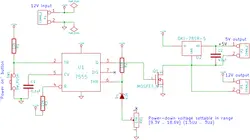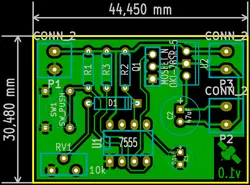Cheap deep discharge protoction for solar batteries
Hello everybody,
recently, I decided to power my Raspberry Pi from my solar battery. However, before I could do that safely, I needed some deep discharge protection for the battery, which had to switch off the Pi when the battery voltage becomes too low.
Most available solutions for this problem missed one of the features I wanted: low current in “off” state, no relays (as the use too much power while active) and low price. So I designed one myself:
You might also want to get the image of the copper layer (SVG) in case you want to etch the board yourself.
In this circuit, the 7555 timer IC is “abused” as a simple monostable flipflop. When the “Power On” button is pressed, the trigger input (TR) is pulled low, which sets the Q output of the IC to 12V and consequently switches on the FET. This state is kept until the voltage at the threshold input (THR) exceeds two thirds of the supply voltage. As the supply voltage is the battery voltage, it will decrease while the battery is discharged. The voltage at THR will also decrease, as it is connected to the supply voltage. However, THR has a specific “minimum level”, which is set by the Z-diode, so at some point, the voltage at THR will be higher than the threshold of 2/3 the battery voltage and Q will be pulled to ground. This causes the load to be effectively disconnected from the battery. Even if the battery voltage rises again (which it does, because the load is disconnected), the load will stay disconnected until the button is pressed again.
In my version, the circuit itself draws about 0.5 mA when the outputs are switched off and 0.6 mA when the outputs are switched on, but without any load (so having the OKI-78SR powered without load doesn’t make a real difference).
If you want to build this board, take care to use the 7555 timer IC in the final version. For a simple test, you could also use a normal NE555 (or similar), but those are not very power efficient (idle current is about 10 mA compared to <0.5mA for the 7555).
The raw costs of the whole board are less than 10 €. The most expensive part is the OKI-78SR with about 4 €, the prices of the other parts are mostly below 0.50 €.
So this little circuit fulfills all my requirements and even has the 5V regulator built in. With this I can finally run devices with solar power without having to worry about the battery.

